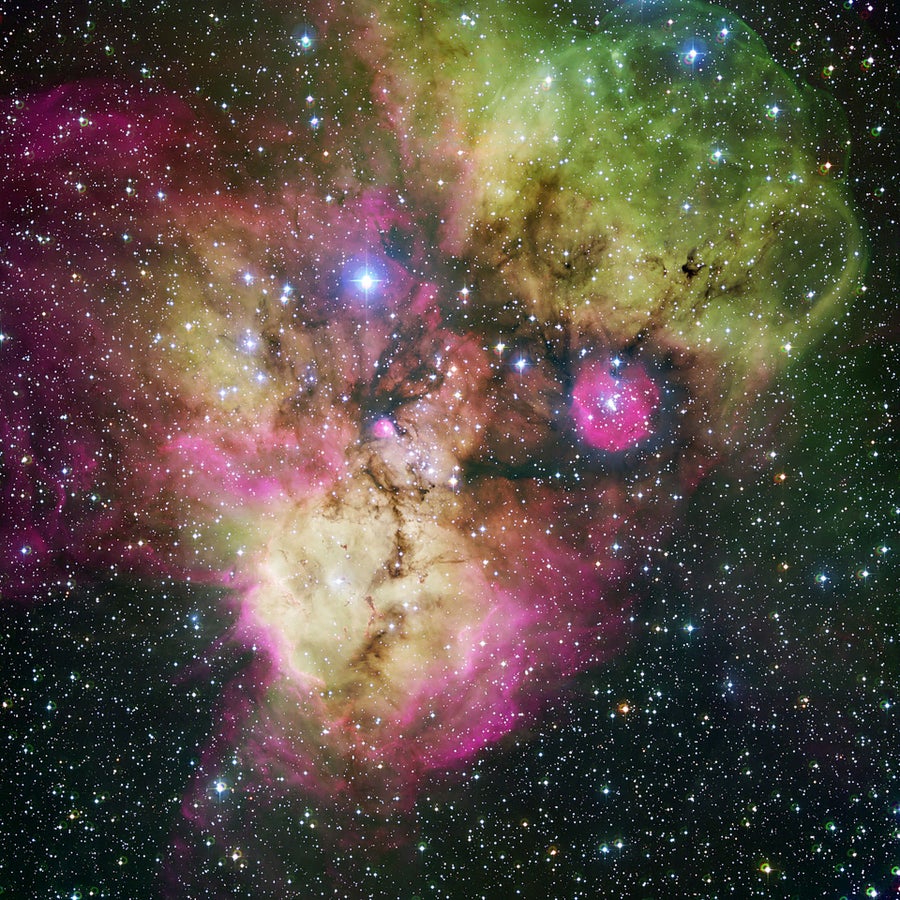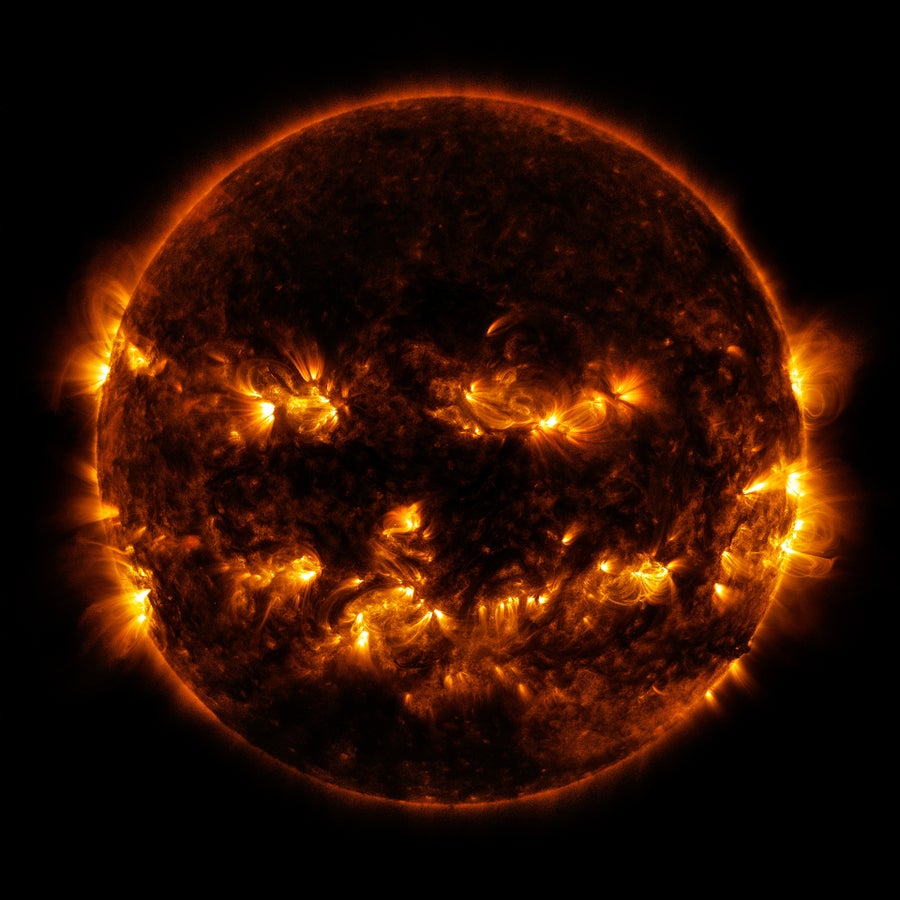Space is scary.
Let’s face it: if I were to magically transport you to a completely random spot somewhere in the universe, chances are higher than 99.99999999 percent that you’d be dead within moments. Feel free to add some 9’s to those odds, too.
If you’re lucky—for a sufficiently broad definition of “lucky”—you’ll materialize over the surface of a star (or inside one) and be vaporized or near a black hole and be shredded by tides or on a planet with a poisonous atmosphere.
On supporting science journalism
If you’re enjoying this article, consider supporting our award-winning journalism by subscribing. By purchasing a subscription you are helping to ensure the future of impactful stories about the discoveries and ideas shaping our world today.
That’s just the reality of it. Space is mostly empty, as near a vacuum as you care to argue, and what isn’t empty is decidedly, and terrifyingly, fatal. It’s rough out there.
That’s how it appears in fiction, too. In our literature, our movies and our imaginations, space is filled with aliens intent on stealing our water, our technology and our lives. Even the most mundane (yet still fictional) UFO story has an edge of creepy-crawliness to it.
Our perception of space is, perhaps, influenced by all this. Certainly there is beauty and awe to fill anyone’s soul, but does a chill draft blow through there as well, leeching ice into the spirit and sending a frisson of tingles down one’s spine?
Now combine that with pareidolia, the tendency for our brain to try to make patterns out of noise. Oh, certainly, we can see happy faces in clouds or a familiar religious icon in a piece of toast. But then there’s also that shadow in the corner of your bedroom at night that becomes a sinister presence. Swaying trees in a storm seem to reach for you—and were those words you heard on the howling wind?
The same sensorial subjectivity is true for objects in space. They take on all manners of shapes, and our brain interprets them as it will.
And of course, it’s the season. It may seem a little odd to celebrate eerie and downright ghastly cosmic caricatures that we spy through our telescopes just because of where Earth is in its annual orbit around the sun, but the pull of Halloween cannot be denied.
So let’s take a look at some spooky spacey specters appropriate for the holiday. After all, they’re literally unearthly.
The Witch Head Nebula
One of my favorite objects in the entire sky, especially for October, is NGC 1909, aka the Witch Head Nebula. Why is it called that? Grab your familiar and a pointed hat and take a peek at this:

The resemblance to, well, the head of a stereotypical witch is remarkable! You can see the pointed chin, the crooked nose, the mouth open, as if uttering a curse, and the eyes staring widely at some horror we cannot perceive.
To throw a bucket of cold water on this, what you’re actually seeing is a cloud of interstellar dust, which consists of tiny grains of rock and carbon-based molecules. Interstellar dust is usually opaque to visible light, but the Witch Head is near the fantastically luminous star Rigel (which you might know better as the right “knee” in the constellation of Orion, from an observer’s point of view) and reflects that intense starlight back to us. The star also warms the dust, and in this image, taken by NASA’s Wide-Field Infrared Survey Explorer, or WISE, we see the thermal infrared glow of the dust. Buried deep inside this cloud are denser spots birthing broods of brand-new baby stars—ironic, given fairy-tale witches’ predilection for devouring children—and in fact it may be part of the vast and sprawling Orion Molecular Cloud complex.
The Flaming Skull Nebula
I remember the first time I saw Sharpless 2-68; my immediate reaction was “Well, that’s the Flaming Skull Nebula right there.” What else would you call this?
![Sh2-68 is an ancient planetary nebula that is estimated to be at least 45,000 years old. The diffuse orange emission to the upper right is the result of the planetary nebula's motion through the disk of our galaxy. The bluish interior is from energized oxygen atoms. The progenitor star is the very blue star at the center of the bluish gas. The image was generated with observations in the Hydrogen alpha (red) and Oxygen [OIII] (blue) filters. In this image, North is right, East is up](https://static.scientificamerican.com/dam/m/149fc0fc5d0a994d/original/sh2-68_flaming_skull_nebula.jpg?m=1729812965.032&w=900)
T.A. Rector (University of Alaska Anchorage)/H. Schweiker (WIYN and NOIRLab/NSF/AURA)
I mean, it’s a skull—with flames.
Okay, yes, it’s actually a planetary nebula, the gas ejected from a sunlike star as it runs out of fuel in its core, sheds its outer layers and begins to die. The stellar “wind” of hydrogen and other elements blown into space is energized by the now exposed, extremely hot core of the star. Oxygen close to the core glows blue, and the cavities in it—the “eyes” and “mouth”—could be sculpted by the interactions of the stellar wind with the environment around the star. The overall “skull” shape arises at some distance from the star as oxygen’s glow fades in the attenuating starlight.
Farther out, though, its hydrogen glows fiercely red. The dying star is also moving rather rapidly, so the thin gruel of interstellar gas blows the expelled hydrogen into a long tail like, well, flames off a skull.
Has anyone told Marvel?
Alien Demon Nebula
That may not be the official name, but I don’t think anyone would argue with me over it:

I am an astronomer and a scientist and someone who has spent decades debunking antiscientific nonsense, and I am here to tell you that this deep-space object is clearly an alien demon head.
Technically, it’s three objects. The star cluster Haffner 18 makes up the “nose.” The “eye” on the right is the star cluster Haffner 19, which contains a large number of massive, luminous stars that light up the gas around them, creating a roughly spherical region of glowing hydrogen called a Strömgren sphere. The “mouth” is the young cluster NGC 2467, also a site of active stellar birth. The bright star marking the “eye” on the left is HD 64455. Confusingly, this object is actually several nebulae, probably at different distances from Earth and superposed along our line of sight, which makes studying them individually difficult.
Or is that just what the gigantic alien demon head wants us to think?!
Skull Asteroid
In 2015 an asteroid passed just 485,000 kilometers from Earth—fittingly, on Halloween. By a bizarre coincidence (or is it?) radar scans of the object revealed that it’s shaped eerily like a human skull.

Called 2015 TB145, it’s about 600 meters in diameter, which means on top of all the fictionally scary things about it, it’s also officially a potentially hazardous asteroid, one with a remote-but-possible chance of striking our planet and dealing us grievous global harm. Happily, we’re safe from this skull-shaped space rock for at least 150 years (plenty of time to do something about it, too, should we find it on an intercept trajectory).
2015 TB145 has an unusual orbit that is highly elliptical and tilted way over from the plane of the planets, which is generally more expected from a comet than an asteroid. It’s also a bit more reflective than typical asteroids—again, more fitting for a comet. It doesn’t show any sign of the usual kind of cometary activity though, possibly having used up all its gas after repeated passes of the sun.
This would make it a dead comet, which, given our theme here, is pretty appropriate.
Sun-o’-Lantern
Not everything in space needs to be spooky to still fit right in with Halloween. On October 8, 2014, NASA’s Solar Dynamics Observatory took a picture of the sun that will carve its way to your heart. It looks particularly pumpkinlike here:

This shot combines two images taken in the extreme ultraviolet—light with far shorter wavelengths than our eyes can see—which highlights magnetic activity. The powerful magnetic fields can lift hydrogen up off the surface, which then follows the huge loops and glows brightly. The sun exhibits an 11-year cycle in its activity, which in 2014 was at its peak, when sunspots were common and these coronal loops arced above them. Most of the loops are tens of thousands of kilometers in height, turning the sun into a colossal solar jack-o’-lantern, albeit one more than a million kilometers wide and blasting out the energy of 100 billion one-megaton nukes every second. And this is a reminder that we’re at the peak of the solar cycle right now, so, once again, as All Hallows’ Eve approaches, ancient and fearsome gourds walk among us.
Happy Halloween!








